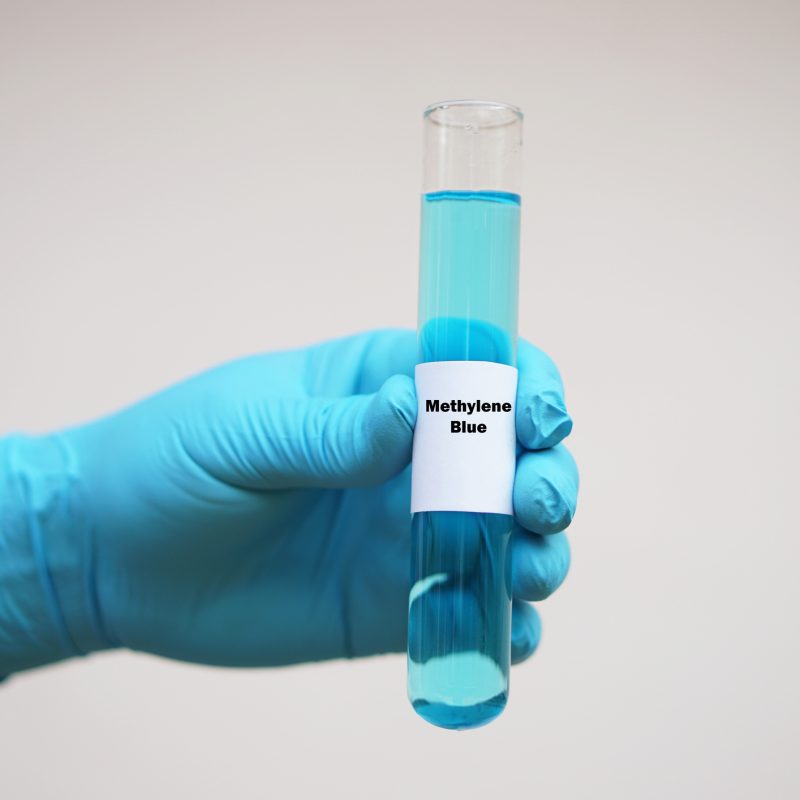
Fitness-related applications for pharmaceutical-grade products seem to pop up with increasing frequency. Methylene Blue has caused quite a stir, touted as the “next best thing” on the never-ending list of exercise supplements. In this article, we present the medical applications of Methylene Blue as well as its evolution into a popular cognitive booster and energy enhancer. We also present a few of the significant health risks associated with unsupervised use.
History of Use
As early as 1876, marking it as one of the world’s oldest organic dyes, methylene blue figured prominently in the textile industry. Over the next several years, scientists began using methylene blue to stain microorganisms in an attempt to diagnose certain infections. In 1891, it proved itself useful as a treatment for malaria, earning it the title of “the first synthetic compound ever used as an antiseptic in clinical therapy and the first antiseptic dye to be used therapeutically,” according to the authors of a Medicinal Research Reviews publication.
Today, the FDA only approves the use of methylene blue in the treatment of methemoglobinemia, a rare condition that restricts the ability of red blood cells to deliver oxygen throughout the body. Methemoglobinemia typically occurs as a result of exposure to certain medications, chemicals, or recreational drugs; methylene blue primarily treats this condition by fostering an increase in the oxygen-binding capacity of hemoglobin. Ironically, skin with a blue-tinged coloration, resulting from inadequate oxygen levels in the blood, symptomatically points to a case of methemoglobinemia, and the treatment itself boasts a vibrant cobalt-blue hue.
Other Medical Applications
Research labs have found various uses for methylene blue 1% solution. As a basic, or cationic, dye, this aqueous biological stain readily binds to acidic compounds like DNA and RNA, making its strong blue color an easy way to enhance microscopic contrast and details. Scientists often use it to facilitate the visualization of nuclei, bacteria, and cellular structures under a microscope.
Methylene blue has proven valuable in treating some additional medical situations ~
- vasodilatory shock (also called distributive shock), a medical emergency in which the body fails to distribute sufficient blood to the heart, brain, and kidneys
- an antidote to cyanide poisoning
- in photodynamic therapy for disorders such as psoriasis and chronic wounds
- to diagnose, manage, or improve the treatment of various types of cancer, including cancers of the breast, mouth, and skin
- used to identify cancer that has spread to a nearby lymph node by staining the lymph node blue
- to ease the pain of oral mucositis, inflammation of the oral mucous membranes that often occurs in patients undergoing either chemotherapy or radiation therapy to the head and neck
Proceed with Eyes Wide Open
As our society clamors for anti-aging products that also boast the potential to increase not just one’s lifespan but the health within those extra years, the popularity of supplements continues to skyrocket. Although evidence of some proposed health benefits remains inconclusive, advocates of methylene blue suggest that it can accomplish the following ~
- slow aging
- enhance memory
- improve mood and focus
- prevent cancer
- reduce the risk of incurable neurological disorders like Alzheimer’s disease.
However, we must recognize and fully acknowledge that the short-term use of a pharmaceutical-grade product in a controlled setting, under the supervision of a seasoned medical provider, differs greatly from buying an unregulated supplement online or at a random supplement market and consuming it every day simply because it claims to provide “loads of energy by enhancing mitochondrial efficiency.”
While methylene blue certainly shows promise as a tool for protecting mitochondria (the energy powerhouses of human cells) against the deleterious effects of growing older, we must caution readers to remain vigilant as companies begin to promote methylene blue as the panacea to reduce cellular aging in the brain, clear out “brain fog,” and cure cancer.
A paper published in 2023 in the Journal of Cerebral Blood Flow & Metabolism reported that methylene blue actually led to an 8% decrease in human brain blood flow. In this lab, the scientists utilized methylene blue in similar doses to those studied by researchers at the University of Texas -Austin, who claimed the compound conferred memory-enhancing properties.
Other researchers have pointed out that even pharmaceutical-grade methylene blue contains some level of impurities, and that neither humans nor animals should ingest either industrial-grade/or chemical-grade methylene blue. If an individual mistakenly purchases the wrong type of methylene blue online, for purposes of consumption, he could end up quite ill. As a case in point, a search for “methylene blue” on Amazon could lead someone to inadvertently purchase fish tank cleaner, as methylene blue proves very useful as an antifungal aquarium disinfectant.
Potential Drug Interactions
Medical professionals often fail to recognize the fact that their patients who take prescription maintenance medications for depression and/or anxiety may also consume unregulated supplements. For instance, methylene blue gets classified as a monoamine oxidase (MAO) inhibitor, a type of drug used to treat depression. It also bears a striking similarity to the chemical structure of some tricyclic antidepressants. This has led companies to advertise methylene blue as a nonprescription alternative to fight depression.
However, if a person is already taking certain antidepressants (Prozac or Cymbalta), adding methylene blue to their lineup, a dangerous and sometimes fatal interaction can occur. Antidepressant medications in particular raise the alarm due to a complication known as serotonin syndrome, a drug reaction that occurs when medication combinations create excessively high levels of serotonin (the “feel good” chemical) in the body. Symptoms can range from mild, such as diarrhea or shivering, to severe, including muscle rigidity, fever, seizures, and potential death if left untreated.
The Positive Side
We have already alluded to a possible link between the methylene blue 1% solution and cellular mitochondria. Dysfunction of the mitochondria often accompanies aging, affecting tissues including the skin and the brain. This, in turn, leads to increased oxidative stress. Specifically, methylene blue claims to bypass Complex I/III activity in mitochondria, thereby lessening oxidative stress to some degree.
According to one theory, cell and tissue aging result from repeated attacks by free radicals. In human cells, reactive oxygen species (ROS) originate primarily in mitochondria, whereas aging, declines in mitochondrial mass, respiration capacity, and respiration efficiency function within a variety of tissues. Dysfunctional mitochondria lead to decreased ATP production as well as increased ROS production, both of which incite further damage to the mitochondria. This vicious cycle leads to severe cellular damage, which, over time, will expedite the aging process. Scientists claim that the antioxidative properties of methylene blue mainly improve mitochondrial function and break the ROS-mitochondrial damage cycle, giving the illusion of a powerful anti-aging drug.
Alzheimer’s Disease and Methylene Blue
Alzheimer’s disease, a neurodegenerative condition that accounts for a significant portion of dementia diagnoses, bears 2 unique hallmarks: Amyloid-β (Aβ) aggregation and neurofibrillary tangles (NFTs). As one might assume, aging ranks as the primary risk factor of dementia in general, including Alzheimer’s disease. Mitochondrial dysfunction could provide a clue to the missing link between aging and this disease. Mitochondria showing reduced size and impaired movement appear with prevalence in a brain addled with Alzheimer’s disease. Moreover, mitochondrial dysfunction causes diminished energy metabolism, alterations in the key enzymes in oxidative phosphorylation, and dysregulation of calcium homeostasis. Since methylene blue can cross the blood-brain barrier (the protective layer that controls the passage of substances between the bloodstream and the brain), some researchers have considered whether it can help reduce oxidative stress on mitochondria and improve memory. Treatment with low doses of methylene blue, under medically supervised conditions, shows promise in reducing ROS production, which might offer a significant benefit to such patients. However, only additional research can help clarify any true efficacy.
Cognitive Enhancement and Memory Boosting Effects
In addition to its purported beneficial role in age-related brain disorders, the methylene blue 1% solution likewise shows promise as a memory enhancer. Since doctors and researchers observe metabolic derangement in older brains, and mitochondrial impairment accumulates over time, improving mitochondria may help neurons maintain their health and improve their functions. Several early studies, conducted on rats and zebrafish, have shown that methylene blue might enhance memory retention by increasing cytochrome oxidase activity and facilitating ATP generation. One such study revealed that brain cytochrome oxidase activity following treatment with a low dose of methylene blue ranked 70% higher than in the control group, and the overall mnemonic capacity during discrimination learning also improved. Another study showed that methylene blue treatments could prevent memory impairment in rats suffering from chronic cerebral hypoperfusion. With functional imaging in the human brain, scientists observed that methylene blue had the potential to modulate task-related and resting-state neural networks, seeming to offer a modicum of cognitive protection against accelerated aging.
Antioxidant and Anti-Inflammatory Protection
As the human body grows older, skin cells take a beating much like other parts of the body. Two different types of skin aging, intrinsic and extrinsic, both demonstrate a loss of elasticity, flattening of the dermal-epidermal junction, and generalized atrophy of the extracellular matrix.
Intrinsic aging manifests itself in the natural physiologic factors. As the proliferation of the basal cell layer decreases, skin cells reach senescence, and collagen expression gets downregulated. Extrinsic skin aging occurs through environmental factors, causing thickening of the skin, decreased proliferation of basal cells, collagen downregulation, and increased oxidative stress. A large fraction of extrinsic aging comes from photodamage (sun exposure) accumulated by ultraviolet rays, leading to a breakdown of collagen, which promotes accelerated aging. Oxidative stress, often spurred on by an imbalance between free radicals and antioxidants in the body, ranks as a key factor in overall aging as well as many chronic diseases, as we have touched upon earlier. Methylene blue, as a potent antioxidant, scavenges free radicals and protects cells from damage.
By reducing oxidative stress, methylene blue may offer protection from conditions like heart disease, diabetes, and even certain types of cancer. It also helps manage inflammation, critical for maintaining overall health and preventing chronic illness.
Athletic Advantages
When a serious athlete finds himself in the throes of pushing his body to its very limits, most likely during training for a competitive event, the muscles and organs demand a huge amount of ATP, or cellular energy. Methylene blue enhances ATP production by improving mitochondrial efficiency and oxygen utilization. Below, we detail some of the well-documented exercise-related benefits of supplementing with methylene blue 1% solution ~
- Reducing Muscle Fatigue
During intense workouts, muscles produce lactic acid, the accumulation of which leads to fatigue. Methylene blue helps buffer lactic acid buildup, reducing muscle exhaustion and allowing for longer, more intense training sessions.
- Boosts Cellular Energy (ATP)
Methylene blue acts as an electron donor in the mitochondrial electron transport chain to ramp up ATP production, providing the energy required to train harder and longer.
- Enhances Oxygen Use
Methylene blue may improve the manner in which cells absorb and utilize available oxygen, delaying the onset of fatigue during endurance workouts.
- Facilitates Recovery
By neutralizing free radicals and fighting oxidative stress, methylene hastens the muscle repair process, reducing the feeling of soreness that typically follows tough gym workouts.
- Optimizes Metabolism
By helping to stabilize redox balance within the body’s cells, methylene blue helps foster better overall metabolic efficiency, building long-term resilience into any training regimen.
- Sharpens Focus/Mental Clarity
Some anecdotal evidence exists that suggests methylene blue can enhance brain function under pressure, keeping an athlete on point and responsive, whether in the gym, on the field or mid-race.
Addressing Cognitive Function and Support
Methylene blue captured medical attention for its potential to improve brain function. By acting as a neuroprotectant, a supplemental methylene blue 1% solution not only reduces oxidative damage in the brain, which can ultimately contribute to cognitive decline; it also promotes the bioenergetics of neurons, supporting brain metabolism and helping to enhance focus, mental clarity, and memory.
By improving neuroplasticity, or the brain’s ability to adapt and build new neural pathways and connections, methylene blue may offer cognitive support for a range of mental health concerns, including age-related cognitive decline, neurodegenerative diseases, and even mild cognitive impairment.
Immune System Modulation and Autoimmune Disease Support
Another compelling benefit of methylene blue comes in the form of immune system support. Studies have shown how supplementation may help in the regulation of the body’s immune responses, particularly in individuals living with autoimmune conditions. By modulating the immune system and reducing inflammation, methylene blue can attempt to manage the overactive immune responses associated with diseases like rheumatoid arthritis, lupus, multiple sclerosis, and other autoimmune disorders.
Methylene blue also demonstrates potent anti-inflammatory properties that can help reduce inflammation throughout the body, which medical professionals recognize as one of the key contributors to chronic disease.
Final Thoughts
Does methylene blue 1% solution qualify as a “magic bullet” in the world of medicine? Does it truly offer any benefit to athletes and their performance, either physically or cognitively? Only additional research will address these and other queries. For now, it seems most uses for methylene blue ought to remain in the realm of physicians attempting to treat very specific health conditions. If athletes do wish to experiment with supplementation, they might consider doing so with a modicum of caution, easing into the practice rather than risking overdosing and potential physical harm.
References
https://www.menshealth.com/nutrition/a69040863/what-is-methylene-blue/
https://nadclinic.com/the-secret-to-enhanced-athletic-performance-methylene-blue/
https://rmreagents.com/product/methylene-blue-1/
https://www.health.harvard.edu/diseases-and-conditions/what-to-know-about-methylene-blue
https://pmc.ncbi.nlm.nih.gov/articles/PMC10638993/
https://www.webmd.com/a-to-z-guides/methylene-blue
https://kingspharma.com/why-athletes-are-turning-to-methylene-blue-for-performance-and-recovery/
https://pubmed.ncbi.nlm.nih.gov/17428524/






